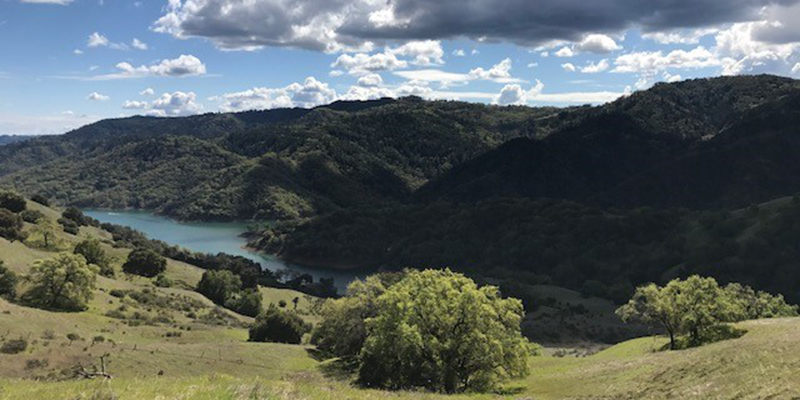
Lake Sonoma watershed (Photo: Walter Kieser)
The damage from California’s wildfire crisis has been painful and relentless. The state has lost lives, property, natural resources, and health and well-being, while solutions are proving elusive and costly.
Among the innovations currently under way to address these challenges is an “enterprise-driven” approach being tested in an area of the state where wildfires have hit again and again: The North Bay counties of Sonoma, Napa, Lake, and Mendocino. The goal is to promote safer, healthier landscapes by quantifying the benefits for nature and people that would come through new economic activities, partnerships, and investments to support large-scale wildfire resilience work.
The effort currently involves five pilot projects in the North Bay area featuring distinct landscapes and conditions – from coastal forests to disadvantaged communities to California’s celebrated wine country. Described as “Natural Enterprise Complexes,” these regions reflect a range of vegetation types, wildfire hazards, ecosystem service potential, governing structures, land ownership, and strategies for adaptation.
The effort is being advanced by a collaborative nonprofit team, “Taking Action for Living Systems (TALS), Inc.” TALS is proceeding in coordination with local government and resource conservation districts, private and public landowners, Fire Safe Councils, Sonoma Ecology Center, and Rebuild North Bay and other local foundations. The effort is focused on advancing climate adaptation and forest health strategies to reduce wildfires risks and losses and improve ecosystem resilience. The pilots are being designed to test the feasibility of an integrated enterprise-driven approach that can be applied elsewhere in the state.
The idea is to quantify monetary benefits and potential revenue streams that can flow from healthy, resilient forests and other fire-prone lands. The benefits can include improved public health and economic vitality, carbon sequestration, biomass energy generation, water supply and water quality enhancement, and sustainable commercial wood products. Such revenue streams could help sustain the costs of wildfire reduction treatments in each Natural Enterprise Complex.
“The goal is to identify what it will take to make these living systems whole and sustainable over time,” said Robert Ewing, who is heading up the TALS team and has provided consulting services on wildfire resiliency issues to the Sonoma County Office of Recovery and Resiliency and a partnership with the Pepperwood Foundation under a grant from the Hewlett Foundation. This work included preparation of a guidance document and a later report that formed the basis for the Natural Enterprise Complex approach.
According to Walter Kieser, senior principal of Economic & Planning Systems and a TALS consulting partner, one of the larger monetary benefits would arise from avoided costs – such as firefighting, property losses, health impacts and economic disruption – when fires don’t occur thanks to healthier landscapes.
Alongside the enterprise-driven strategies, the effort is exploring effective institutional responses at the state, regional and local levels, and partnerships among landowners, businesses, service organizations, and public agencies.
The five pilots include the following areas, each with distinct demographics, geographies, and governing structures, as well as unique capacity and investment needs ranging from mills, powerplants and physical equipment to improvements in transportation, education, and planning and regulatory procedures.
- Lake Sonoma Watershed. Lake Sonoma serves 600,000 customers in Sonoma and Marin Counties. The upper watershed covers 87,000 acres in Sonoma and Mendocino Counties. It is mostly privately owned and needs major fuel reduction work to reduce fires. Currently, Sonoma Water is working to support landowners in reducing wildfire risks and hardening their homes. Potential enterprise opportunities include water enterprise value and monetizing fire-related cost avoidance.
- Coastal Forests. The effort is targeting a 500-square mile area in the coastal portions of Sonoma and Mendocino counties, where coastal redwood forests dominate and major environmental and recreational assets are present. The area includes the coastal communities of Sea Ranch and Gualala. TALS is working to coalesce a diverse leadership group and multi-owner restoration and treatment strategies. Enterprise opportunities include carbon storage and cost avoidance benefits.
- Mark West Wildland Urban Interface Area. Home to 50,000 people, this 60,000-acre area runs from US 101 east to the Napa County line and encompasses the upper watershed of Mark West Creek. Wildfires have swept through this complicated topography for decades, including the 2017 Tubbs Fire. The enterprise-driven approach is focused on wildfire management strategies to reduce fire-related costs and supporting existing and new local organizations and funding strategies.
- Lake County. Lake County is one of the poorest counties in California. It covers 1,329 square miles, has 65,000 residents, and is prone to wildfires. Local government entities recently formed a joint powers authority, the Lake County Community Risk Reduction Authority, which offers low- and no-cost risk reduction grants to homeowners and landowners for wildfire risk reduction work. Opportunities to monetize benefits are challenging here and TALS is working with the JPA to expand treatment funding opportunities.
- Napa County. This 729-square mile area with 138,000 residents is home to the world-famous Napa Valley. The wine industry and tourism are major economic forces. The upland portions of the county have been hit by repeated fires. The Napa County Resources Conservation District and local Fire Safe Councils are working to develop a county-wide wildfire risk reduction strategy. TALS is collaborating. Here, too, avoided cost benefits are being explored for monetization and organizational purposes.
A recent study by the Public Policy Institute of California (PPIC) underscored the importance of understanding the benefits and beneficiaries of headwater forests as a means of generating policy discussions and motivating long-term investments in effective forest management.
These types of efforts and strategies, which are being advanced by the TALS effort in the North Bay, are among the approaches being explored by the California Economic Summit to reduce wildfires and create more climate resilient landscapes. Revitalizing rural economies, creating jobs, reducing smoke impacts, and protecting water resources are among the multiple benefits of wildfire risk reduction work highlighted by the Summit’s recently released report, “California’s Wildfire Crisis: A Call to Action.”

